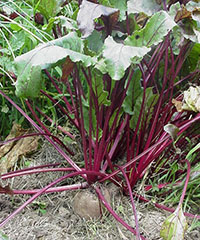Root Crops
Root crops include a number of vegetables grown for their enlarged, edible storage root. They are hardy, cool-season crops with a long storage life. While they belong to several unrelated plant families, these crops have similar cultural requirements.
Marketing
 Kentucky-grown root crops are mainly sold through local fresh markets, such as farmers markets, on-farm stands, produce auctions, and community supported agriculture (CSA) programs. Root crops are typically inexpensive to grow and make a nice addition to a farmers market mix. Quality heirloom variety root crops have been good sellers in some Kentucky farmers markets, and fresh roots can also be marketed to local grocery stores and restaurants, with many chefs showing continued interest in seasonal and heirloom vegetables.
Kentucky-grown root crops are mainly sold through local fresh markets, such as farmers markets, on-farm stands, produce auctions, and community supported agriculture (CSA) programs. Root crops are typically inexpensive to grow and make a nice addition to a farmers market mix. Quality heirloom variety root crops have been good sellers in some Kentucky farmers markets, and fresh roots can also be marketed to local grocery stores and restaurants, with many chefs showing continued interest in seasonal and heirloom vegetables.
Production
 Carrots, Daikon radish, horseradish, parsnip, radish, and rutabaga are raised only for their roots, while beets and turnips may be grown for their tops as well. Salsify is cultivated primarily for its long, tapering root, but the grass-like leaves can also be added to salad greens. Jerusalem artichoke is considered a weed by many, while others consider its water chestnut-flavored tubers a gourmet item; the tubers are used fresh in salad, cooked like potatoes, or pickled. Varieties within each crop can differ in root characteristics (such as size and color), disease resistance, and flavor. Consideration should be given to regional preferences, as well as whether to grow heirloom cultivars. Growers should select only adapted varieties that have the qualities in demand for the intended market.
Carrots, Daikon radish, horseradish, parsnip, radish, and rutabaga are raised only for their roots, while beets and turnips may be grown for their tops as well. Salsify is cultivated primarily for its long, tapering root, but the grass-like leaves can also be added to salad greens. Jerusalem artichoke is considered a weed by many, while others consider its water chestnut-flavored tubers a gourmet item; the tubers are used fresh in salad, cooked like potatoes, or pickled. Varieties within each crop can differ in root characteristics (such as size and color), disease resistance, and flavor. Consideration should be given to regional preferences, as well as whether to grow heirloom cultivars. Growers should select only adapted varieties that have the qualities in demand for the intended market.

